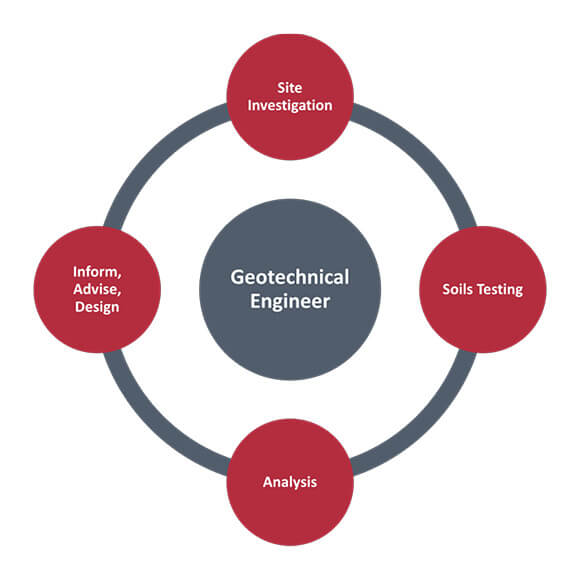Top Guidelines Of Geotheta
Top Guidelines Of Geotheta
Blog Article
Getting The Geotheta To Work
Table of ContentsAll about GeothetaIndicators on Geotheta You Need To KnowUnknown Facts About GeothetaThe 9-Minute Rule for Geotheta
They team up with civil designers, structural engineers, designers, and other specialists to incorporate geotechnical factors to consider right into the general job style and building process. This requires reliable synergy, sychronisation, and interaction to make certain that the geotechnical elements line up with the project objectives and fulfill regulatory needs.Mining & Products Design: Principles of boring, penetration prices, and factors influencing the choice of exploration approach. Blowing up techniques in surface and underground functions. Mechanical and constant approaches to fragmentation, consisting of longwall shearing and fullface boring.
Modelling of piece and fragment size circulations; comminution as a transfer feature. Comminution technology: squashing, grinding, size classification. Integrated evaluation of fragmentation and comminution operations. Offered by: Mining & Products Engineering.
Some Known Incorrect Statements About Geotheta
Bachelor's level programs in civil, geotechnical, geological, and environmental engineering normally last 4 years and consist of basic education courses in English, social science, and the humanities, as well as training courses in innovative maths, architectural geology, and liquid mineralogy. (https://www.cheaperseeker.com/u/geotheta)
Geotechnical engineering involves the analysis of the soil and rock problems at a particular site, and their ramifications for the growth of that website. As most structures rely upon the ground for support, it is without shock that a thorough understanding of the ground conditions, and the viability of structure systems, are important to the long-lasting security and performance of the building or framework.
Being experts in the examination of geological developments and ground practices, geotechnical engineers execute scientific investigations and testing to comprehend the influence these geological formations may have on the style and building and construction of structure, civil and infrastructure projects. This proficiency is essential for the style and building and construction of structures, roadways, passages, dams, bridges, and water system and sewage systems.
The geotechnical team at Douglas Allies consistently seek advice from engineers, design engineers, developers, and home builders to make suggestions on layout and development proposals to guarantee that the developed structures are accordingly made for the ground problems. The layout of footing systems requires to think about the weight of the framework, the ability of the ground to support that weight with each other with movement tolerances and reliable building and construction.
The Facts About Geotheta Revealed
This task is significantly streamlined by the use of our Douglas Map geospatial platform that makes this details easily available in a very easy to utilize web internet browser interface. A geotechnical designer will route the boring of boreholes and examination pits to collect dirt and various other samples, and likewise evaluate surface area features and ground direct exposures to develop a geotechnical version of the subsurface conditions.
Relying on the job type and ground problems experienced, laboratory testing may amongst other points assess stamina, compressibility, sensitivity and/or permeability of soil and rock examples. Hereafter data is gathered and collected, the outcomes are utilized for a geotechnical design of the website, which is generally offered as sections across the site.

A geotechnical investigation naturally can only analyze the ground problems at the areas pierced or excavated. Natural variants in soil and rock conditions can occur across a site and between examination areas. It is therefore good technique that the geotechnical engineer be maintained throughout building and construction of the job to offer on-site verification that the ground problems encountered are consistent with the expectations and advice given in the geotechnical examination report.
About Geotheta
Geotechnical engineers use their in-depth knowledge of dirt and rock to examine threat and resolve problems on varied infrastructure projectsGeotechnical design is a specialist branch of civil engineering which takes a look at the behaviour of planet materials and the application of soil and rock mechanics. Geo Tech Engineer. As a geotechnical engineer, you will certainly analyze the physical, mechanical and chemical properties of soil and rock in order to design structures, retaining frameworks and earthworks
Geotechnical engineering is carefully connected to and overlaps with, both design geology and ground engineering - https://geotheta.wordpress.com/2024/08/02/unlocking-the-secrets-of-geotechnical-engineers-the-geotheta-advantage/. It's feasible to be experts in geotechnics or benefit a geotechnical firm yet be called a design rock hound or a ground engineer. As a geotechnical engineer, you'll require to: develop and preserve relationships with customers and other professionals entailed in the site, throughout each projectmaintain security standards on website bear in mind cost effects when you make recommendationsstudy geological maps and airborne photos from a variety of sources and from different time periodsexamine building plans to see exactly how practical they are based on your understanding of the siteinvestigate risks or anchor geological threats for the sitesearch for eco sensitive attributes, such as land fill beginning to establish valid and expository ground modelsplan field investigationsdrill and evaluate samples of bedrock, soil, groundwater and added materials manage various other experts on sitesolve technological problems as they develop, such as unexpected frameworks at drill sitesmonitor conditions throughout and after building and construction to see to it frameworks are steady in the short and long termadding information accumulated on site to your preliminary researchcreating geotechnical calculations, illustrations, and two or three-dimensional computer system models analyzing the datamaking recommendations regarding the proposed use the website

Report this page